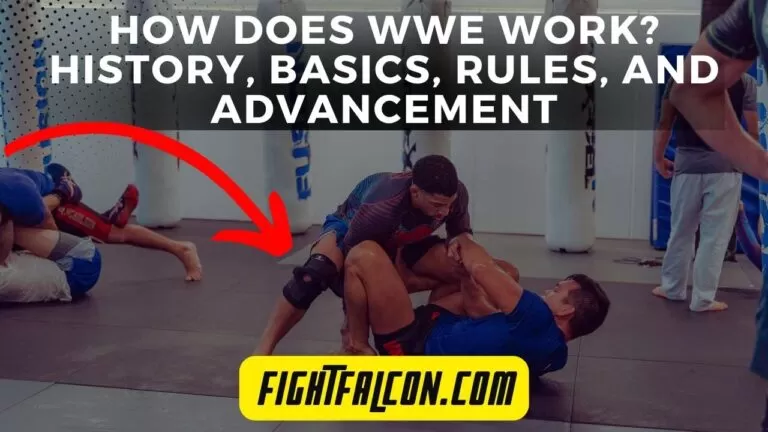Is Wrestling Dangerous? Injuries and Safety Ratio
Wrestling, a sport steeped in tradition and enjoyed by people from every age group, is a fascinating exhibition of strength, strategy, and resolve. As wrestlers collide on mats and rings, many think wrestling is dangerous.
Is wrestling dangerous? Even though Wrestling is a scripted sport, there is still the danger of major injuries for wrestlers involved. These injuries include physical as well as mental injuries. But, there are preventive measures in place to avoid these injuries.
Further in this article, you will learn much more in-depth about the injuries that wrestling could lead to and why non-athletes should avoid this sport. However, to protect the groin, they wear cups.
So, stick around till the end and take advantage of every detail.
Top 5 Most Common Wrestling Injuries

1. Sprains And Strains
These injuries frequently occur in the ankles, knees, and shoulders, necessitating preventative measures.
Dynamic warm-up practices combined with an emphasis on controlled movements can greatly reduce the incidence of such injuries.
Wrestlers must grasp the necessity of avoiding excessive force and focusing on precision when performing their methods.
2. Contusions And Bruises
Wrestling is all about close contact, which results in a slew of contusions and bruises. Repeated contact with the mat and opponents is an unavoidable feature of wrestling.
To combat this, wrestlers should get familiar with protective gear and the skill of landing gracefully, which can assist in cushioning the blow and reduce the possibility of severe damage.
3. Fractures And Dislocations
Fractures and dislocations can occur due to high-impact throws and unexpected landings.
Wrestlers must be acutely aware of the associated risks, and coaches must encourage proper move execution to reduce injuries.
Learning to absorb and distribute impact properly during throws and landings can help prevent fractures and dislocations.
4. Concussions
Concussions are rare in wrestling than in contact sports like football, although they can still happen as a result of takedowns, throws, and accidental contacts.
Proper technique and consideration for the opponent’s safety are critical in preventing concussions.
Wrestlers should be taught the symptoms of a concussion and the significance of obtaining medical assistance if a head injury is suspected.
5. Skin Infections
Wrestling’s close skin-to-flesh contact produces an environment favorable to the spread of skin infections.
Ringworm and impetigo are two conditions that can spread quickly among wrestlers.
Regular skin examinations, severe hygiene procedures, and adherence to clean, uniform protocols are critical in stopping the tide of skin illnesses.
High School Wrestling Accidents

1. Growth Plate Injuries
These injuries have the potential to impair bone growth and have long-term consequences.
During this stage, coaches, parents, and medical professionals must be vigilant. Tailoring training programs to accommodate developing bodies and ensure proper nourishment is critical.
2. Overuse Injuries
Youth zeal can lead high school players to overtrain, resulting in overuse ailments, including stress fractures and tendinitis.
Coaches should emphasize the necessity of a well-balanced training and rest schedule. Overuse injuries can be avoided by creating an environment in which athletes appreciate the importance of rest.
3. Emotional Stress
Academic and athletic performance pressures can cause severe mental stress in high school wrestlers. This stress can emerge physically, impacting both mental and physical well-being.
Open communication routes between coaches, parents, and peers help ease this emotional weight.
4. Weight-Cutting Practices
High school wrestlers frequently use severe weight-cutting measures to fit into specified weight classes.
These activities can be dangerous, resulting in dehydration, weakened immune systems, and poor performance.
Coaches, nutritionists, and parents must work together to guide good weight management techniques.
5. Accidents Due To Lack Of Experience
Novice high school wrestlers may need more sophisticated techniques than their seasoned counterparts. This lack of experience might lead to mishaps and injuries.
Coaches should emphasize incremental skill development and foster a healthy environment for learning and growth.
The hazards associated with inexperience can be mitigated by proper supervision and direction during practice sessions.
Wrestling Injuries Compared To Other Sports

1. Contact Sports Vs. Non-Contact Sports
The intrinsic physicality of wrestling distinguishes it from non-contact sports such as swimming.
While wrestling has a higher risk of injury due to the close-quarters nature of its contacts, the controlled structure of its interactions reduces the severity of injuries.
On the other hand, non-contact sports may have reduced injury risks, but they can be more severe when injuries do occur.
2. Injury Types
The emphasis on controlled grappling in wrestling leads to a high rate of musculoskeletal injuries.
On the other hand, high-speed contact sports frequently result in catastrophic injuries such as concussions and fractures.
Wrestling technique and execution that is measured can considerably lessen the chance of catastrophic injuries.
3. Preventive Measures
The special emphasis on technique and controlled contact in wrestling is a paradigm for injury avoidance. Its concepts can be applied to other sports where technique-driven training can cut injury rates significantly.
The emphasis on thoughtful movements and body placement can serve as a model for safety throughout athletic disciplines.
4. Injury Rates
According to statistical analysis, wrestling’s injury rates are equivalent to those of other contact sports. This emphasizes the general importance of efficient injury prevention techniques, regardless of the type of injuries connected with each sport.
The emphasis on safety should extend beyond the confines of athletics.
Impact Of Wrestling On Body
1. Strength And Conditioning
Chain Wrestling’s strenuous demands develop exceptional strength and cardiovascular fitness.
The sport’s hard practices sculpt lean muscle mass and improve endurance, resulting in a more robust overall body.
2. Joint Stress
Wrestling’s complicated holds and maneuvers put a lot of strain on joints and ligaments.
Wrestlers must emphasize flexibility exercises and rigorous warm-up procedures to reduce joint stress and improve general mobility. This preventive strategy can help to maintain joint health over time.
3. Cardivascular Fitness
Wrestling matches need quick bursts of energy, fostering exceptional cardiovascular fitness.
This increased endurance improves mat performance and leads to better heart health and overall well-being.
4. Balance And Coordination
Wrestling requires precise control over bodily motions, which promotes improved balance and coordination. These characteristics transcend beyond the mat, improving individuals’ success in other sports and daily activities.
How To Prevent Wrestling Injuries?

1. Proper Technique
Coaches have the authority to stress the importance of proper technique in young wrestlers.
Controlled execution and sound technique, rather than brute force, can considerably lessen the chance of injury. Wrestlers should remember that accuracy triumphs over aggression.
2. Strength And Conditioning
Regular strength and fitness training lays the groundwork for injury prevention. Wrestlers should follow extensive fitness programs that include strength, endurance, and flexibility.
Coaches and trainers can work together to create programs tailored to each individual’s needs.
3. Dynamic Warm-Up
Every wrestling session should begin with vigorous warm-up routines. These warm-up activities improve blood flow and joint mobility, preparing the body for the physical demands.
4. Hydration And Nutrition
Proper hydration and diet are critical components of peak performance and injury prevention.
Wrestlers must drink enough water and juices to avoid dehydration, and a nutrient-rich diet prepares their bodies for the rigors they will face.
5. Rest And Recovery
Wrestlers must understand the symbiotic relationship that exists between training and recovery.
Overtraining can result in burnout, increased injury risk, and decreased performance. Rest, appropriate sleep, and recovery routines must be prioritized for injury prevention.
Watch Video: Why Is Wrestling Dangerous?
Injury Prevention Resources for Parents and Coaches
1. Coaching Education
Coaches should continue to learn about injury prevention measures and coaching best practices.
Coaches can use this information to create an atmosphere that stresses safety, learning, and athlete growth.
2. Parental Involvement
Parents have a critical part in ensuring their child’s well-being. Maintaining open communication with coaches about the athlete’s medical history, continuing health concerns, and any changes in physical condition is critical.
3. Medical Support
Access to medical practitioners knowledgeable about sports injuries is a major asset.
Coaches and parents should work with these specialists to ensure minor injuries are evaluated and treated as soon as possible.
4. Nutrition Guidance
Working with nutritionists can help parents and coaches create dietary regimens that align with wrestlers’ energy needs and health goals. The ultimate goal is to maintain a healthy weight without sacrificing performance.
5. Mental Health Awareness
Athlete safety includes both emotional and physical well-being. Coaches and parents must create an environment where athletes feel safe sharing their emotional struggles.
Recognizing indicators of emotional stress and having access to mental health support is critical.
Conclusion
The interaction between risk and safety highlights the essence of wrestling in its rich tapestry.
While there are inherent hazards in wrestling, these risks are not insurmountable. Wrestlers of all ages can embrace the sport’s innate virtues while protecting their physical well-being through rigorous study, exquisite technique, and unrelenting vigilance.
Wrestling transcends its hurdles because of the discipline it teaches, the strength it teaches, and the friendship it fosters.
In wrestling, as in life, the pursuit of excellence and safety are inextricably linked, enhancing the path with victories that extend beyond the confines of the mat.







